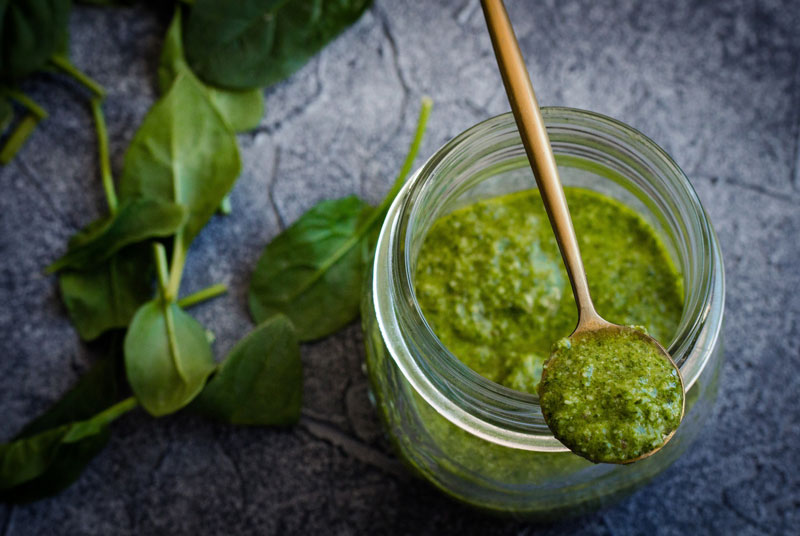 Rich, lively, and pungent, a first-class pesto sauce is among the true delights of Italian cuisine. Yet, its bold, intense flavors– salty, floral, bitter, and slightly creamy–can make wine pairing a challenge. To make matters more difficult, pesto sauce is prepared raw, which means that there is no use of heat to help mellow the flavors. With all of that going on, the last thing you need is an oaky or overly fruity wine to spoil the fun.
Rich, lively, and pungent, a first-class pesto sauce is among the true delights of Italian cuisine. Yet, its bold, intense flavors– salty, floral, bitter, and slightly creamy–can make wine pairing a challenge. To make matters more difficult, pesto sauce is prepared raw, which means that there is no use of heat to help mellow the flavors. With all of that going on, the last thing you need is an oaky or overly fruity wine to spoil the fun.
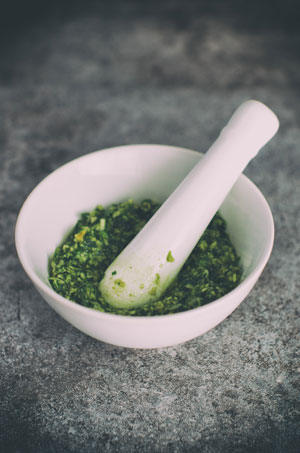 The most traditional style, pesto alla Genovese, comes from the Ligurian coast and dates back at least 150 years. This classic recipe always includes the exact same seven ingredients: fresh basil, pine nuts, garlic, olive oil, Pecorino cheese, Parmigiano cheese, and sea salt. Of course, there are numerous variations (any of which might be considered a capital offense in Genoa), but this simple combination (customarily crushed with mortar and pestle) is perhaps the most time-honored. (There is one particular variant, sometimes referred to as pesto alla Portofino, that adds crushed or pureed tomatoes to the mix and is certainly worth investigating.)
The most traditional style, pesto alla Genovese, comes from the Ligurian coast and dates back at least 150 years. This classic recipe always includes the exact same seven ingredients: fresh basil, pine nuts, garlic, olive oil, Pecorino cheese, Parmigiano cheese, and sea salt. Of course, there are numerous variations (any of which might be considered a capital offense in Genoa), but this simple combination (customarily crushed with mortar and pestle) is perhaps the most time-honored. (There is one particular variant, sometimes referred to as pesto alla Portofino, that adds crushed or pureed tomatoes to the mix and is certainly worth investigating.)
Pairings for Pesto alla Genovese
For pesto alla Genovese, one of the first varietals that leaps to mind is vermentino. Usually quite dry and boasting a vibrant saline quality, vermentino doesn’t get in the way. It’s crisp, refreshing, and often boasts a delicate citrus note, helping to cleanse the palate.
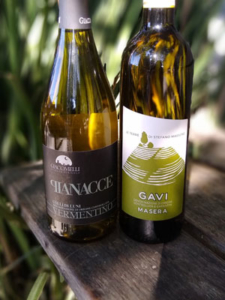 In keeping with the dish’s Ligurian roots, look for vermentino (and the closely related pigato) from coastal Ligurian appellations like Riviera Ligure di Ponente and Colli di Luni (which overlaps into Tuscany). Another neighboring contender is the sleek, bright, subtly fruited Gavi, which is made from the cortese grape and originates in Piemonte, just north of the Ligurian border. At Paul Marcus Wines, you can find the bracingly fresh vermentino Colli di Luni from Giacomelli, along with the ripe but balanced Gavi Masera by Stefano Massone.
In keeping with the dish’s Ligurian roots, look for vermentino (and the closely related pigato) from coastal Ligurian appellations like Riviera Ligure di Ponente and Colli di Luni (which overlaps into Tuscany). Another neighboring contender is the sleek, bright, subtly fruited Gavi, which is made from the cortese grape and originates in Piemonte, just north of the Ligurian border. At Paul Marcus Wines, you can find the bracingly fresh vermentino Colli di Luni from Giacomelli, along with the ripe but balanced Gavi Masera by Stefano Massone.
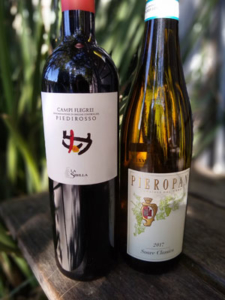 Our next stop is in the Veneto region of northeast Italy, specifically the Soave DOC outside of Verona. The whites of this area feature the garganega grape; though still dry and zesty, Soave wines offer an oily texture, undertones of wildflowers, and a suggestion of almonds that complement the flavors of pesto rather well. We’re proud to include a selection from Pieropan at Paul Marcus Wines, which is one of the area’s most renowned producers, as well as offerings from Suavia and Ca’ Rugate.
Our next stop is in the Veneto region of northeast Italy, specifically the Soave DOC outside of Verona. The whites of this area feature the garganega grape; though still dry and zesty, Soave wines offer an oily texture, undertones of wildflowers, and a suggestion of almonds that complement the flavors of pesto rather well. We’re proud to include a selection from Pieropan at Paul Marcus Wines, which is one of the area’s most renowned producers, as well as offerings from Suavia and Ca’ Rugate.
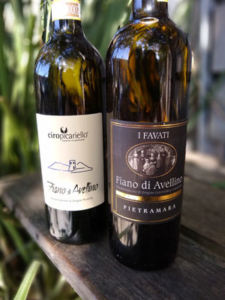 If you’re looking for a pesto partner that will stand toe to toe with your fragrant and verdant sauce, go for Fiano di Avellino from the southern region of Campania. Occasionally referred to as “pesto in a bottle,” fiano’s wild intensity will only enhance the flavor explosion that pesto sauce provides. Robust, nutty, aromatic, and herbaceous, fiano realizes its finest expression when grown on Campania’s volcanic terrain, giving it a flinty edge. Top it off with a zippy acidity, and you have a grape that’s ready to tangle with a top-notch pesto. For a lighter, fresher expression, grab a bottle of Pietramara, made by I Favati, at Paul Marcus Wines, or go to the age-worthy version produced by Ciro Picariello, which is a bit richer and rounder.
If you’re looking for a pesto partner that will stand toe to toe with your fragrant and verdant sauce, go for Fiano di Avellino from the southern region of Campania. Occasionally referred to as “pesto in a bottle,” fiano’s wild intensity will only enhance the flavor explosion that pesto sauce provides. Robust, nutty, aromatic, and herbaceous, fiano realizes its finest expression when grown on Campania’s volcanic terrain, giving it a flinty edge. Top it off with a zippy acidity, and you have a grape that’s ready to tangle with a top-notch pesto. For a lighter, fresher expression, grab a bottle of Pietramara, made by I Favati, at Paul Marcus Wines, or go to the age-worthy version produced by Ciro Picariello, which is a bit richer and rounder.
Unfortunately for red-wine drinkers, tannins and pesto are generally not friends; prominent tannins will only serve to accentuate the bitterness of the dish and obscure its fresh, herbal magic. However, if you must turn to a red wine, piedirosso (also from Campania’s volcanic soils) delivers smoky, savory notes along with decidedly mild tannins and a medium body. Try La Sibilla’s piedirosso, from Campi Flegrei, available at Paul Marcus Wines.
For more about these suggestions, please visit us at the shop. If you have any pairing questions you’d like to discuss, email us at info@paulmarcuswines.com.
Celebrate National Goat Cheese Month
PairingsLadies and gentlemen, we interrupt our regularly scheduled wine programming to bring you this special report: August is National Goat Cheese Month! Of course, here at Paul Marcus Wines, we always jump at the chance to promote the most famous of all culinary pairings: cheese and wine!
In order to do so, we enlisted the help and expertise of the good folks at Market Hall Foods. (A big thank you to Sara and the cheese specialists at Market Hall, who showcased a variety of goat cheeses from France, Italy, and Spain.) Although this selection focuses on European cheeses, rest assured that there are also many delicious and artisanal goat cheeses produced locally and throughout the U.S. So many goat cheeses from which to choose, with so little time!
To complement this lovely cheeseboard, we selected a wine for each offering. When choosing a wine to pair with any cheese, the most important factors are the primary ingredients (goat, cow, sheep) and style of preparation (fresh, blue, washed, aged, etc.). For stress-free pairings, be sure to ask your cheesemonger which style of goat cheese they recommend, as the selection will most likely vary from day to day. And without further ado, let’s dive in!
Goat Cheese: Cevrin with Herbs
Produced in the foothills of Piemonte, Italy, this fresh goat cheese is primarily a goat’s milk cheese, blended with smaller amounts of cow’s and sometimes sheep’s milk. Light and creamy, the inherent freshness and primary flavors of Cervin make it the perfect vehicle to pair with fresh herbs from the region.
Goat Cheese: Fleur de Ré
This artisanal goat cheese comes to us from France’s Loire Valley. A tangy, creamy example of a bloomy-rind style of cheese, it’s coated in a very thin layer of ash before it undergoes aging, or affinage. It is accompanied by a very light sprinkle of fleur de sel from the Île de Ré, located off the west coast of France near La Rochelle. The use of both vegetable ash and fleur de sel enable this little puck of goodness to ripen more slowly and gracefully. A perfectly ripe Fleur de Ré will often exhibit complex notes of salt, earth, and fresh hay, with a noticeable creamy tang on the finish.
Goat Cheese: Truf di Capra
If you like Brie, then you must try Truf di Capra, an indulgent bloomy-rind, extra creamy Italian cheese produced in the foothills of Piemonte, Italy. This special soft cheese includes morsels of black truffle throughout, adding richness and earthiness. The addition of cow’s milk cream also ups the creaminess factor substantially.
Goat Cheese: Bleu de Chèvre
Bleu de Chèvre is unusual in that most blue-veined cheeses are produced from cow’s milk. Not to worry, as this example, produced by happy French goats, is delectable! In addition to the creamy texture and decisive nutty sweetness often found in blue cheeses, the use of goat’s milk imparts a bit of tang on the finish.
Goat Cheese: Garrotxa
This semi-hard, aged goat cheese hails from the Garrotxa area in Catalonia, Spain. It is a region world-renowned for the high quality and unique flavor profile of its goat’s milk. The exterior is most often covered in a hard outer casing of gray mold. Stick to the interior portion of Garrotxa, and you’ll be rewarded with a creamy cheese reminiscent of damp earth, nuts, and dried herbs, with a slightly salty finish.
Happy National Goat Cheese Month from Paul Marcus Wines! We’ll see you at the shop.
Paul Marcus Wines History: Part II
NewsEven as Paul Marcus Wines embarks on its 33rd year serving the friendly folks of Rockridge and the greater Bay Area, Paul doesn’t spend a lot of time celebrating milestones. Instead, he is always focusing on the moment at hand, which means searching for and tasting another wine to thrill and delight his clientele.
With the shop’s prime location–inside the European-styled Market Hall and across from the BART station–Paul never doubted his business would be a success, thanks to what he affectionately refers to as its “captive audience.” If you put out high-quality wines, he knows, the customers will follow along. However, with that built-in opportunity comes great responsibility. It requires steering your clients in new directions while simultaneously listening to their feedback and keeping them satisfied. PMW has been building that trust for three decades, and it remains the shop’s most valuable asset.
Not surprisingly, PMW has always placed an emphasis on European wines, offering ideal counterparts to the meat, fish, produce, and specialty foods sold by its neighbors. In the beginning, when it was just Paul and Joel each working six days a week, the shop featured at least 60 percent imports, and that proportion has only increased since then.
Though Paul was initially attracted to the wines of Bordeaux and the Rhone Valley, he’s developed over time an enormous affection for the grapes of Burgundy, Piedmont, and Tuscany–namely, pinot noir, nebbiolo, and sangiovese. These are grapes that proudly display their terroir, that distinct sense of place; they boast balanced mouth feel and are structured yet elegant. As any PMW regular knows, these wines represent the backbone of the store.
Along with his selection of splendid bottles, Paul also takes enormous pride in the quality of his staff. From the beginning, he has tried to hire people with diverse interests and full lives outside of the shop: artists, musicians, actors, writers, professors, etc. If you allow your employees freedom to pursue outside interests, he believes, they’re better workers in return because they’re content.
It’s worth noting that Paul often enjoys hiring novices who are willing to learn and might bring a different perspective to the store, in addition to people with wine-industry experience. (He relishes shaping the palates of the newcomers.) Employees are encouraged and incentivized to take home wine; by experimenting with food pairings at home, they can better serve the customers and respond to their tastes and tendencies.
An owner who is guided by intuition as much as anything, Paul has always looked to hire self-motivated people with a strong curiosity and a desire to develop new ideas, concepts, and approaches. Already in 2019, PMW has launched the Wine League, improved and expanded its online presence, and installed a new state-of-the-art inventory system. Even after more than 32 years, the shop is moving boldly into the future while still retaining the homespun qualities that have helped make it a Rockridge stalwart.
To be sure, Rockridge has changed dramatically over the years. As the neighborhood has become a little denser, and its denizens perhaps a little younger, the average PMW customer has shown a bit more sophistication. Pleasing them all is a challenge that Paul and his staff embrace with gusto. Wine is food, after all, and few pleasures in life can match a perfect wine pairing, whether it is for a simple weeknight pizza, special occasion, gourmet feast, or anything in between.
Prickly Pairings: Pesto alla Genovese
PairingsPairings for Pesto alla Genovese
For pesto alla Genovese, one of the first varietals that leaps to mind is vermentino. Usually quite dry and boasting a vibrant saline quality, vermentino doesn’t get in the way. It’s crisp, refreshing, and often boasts a delicate citrus note, helping to cleanse the palate.
Unfortunately for red-wine drinkers, tannins and pesto are generally not friends; prominent tannins will only serve to accentuate the bitterness of the dish and obscure its fresh, herbal magic. However, if you must turn to a red wine, piedirosso (also from Campania’s volcanic soils) delivers smoky, savory notes along with decidedly mild tannins and a medium body. Try La Sibilla’s piedirosso, from Campi Flegrei, available at Paul Marcus Wines.
For more about these suggestions, please visit us at the shop. If you have any pairing questions you’d like to discuss, email us at info@paulmarcuswines.com.
Regional Roundup: Bandol
RegionsSay the word “Bandol,” and visions of blue-green waters, framed by white rock and graceful Mediterranean pines, immediately come to mind. However, there is more to this zone of Provence than just the Cote d’Azur’s outrageously beautiful coastline. Here, limestone soils, the sun’s generous warmth, and a refreshing coastal climate create an ideal environment for cultivating the late-ripening mourvèdre, Bandol’s flagship grape.
Wine map of Provence showcasing Bandol
Aside from mourvèdre, lighter varieties such as grenache and cinsault–both traditionally associated with Provençal rosés–are also permitted. However, the heavier-hitting mourvèdre grape must still make up at least 50 percent of rouges or rosés (although many producers choose to use more). While Bandol reds can be extremely tannic and take years to open up fully, the same cannot be said of the region’s rosés. Bright, full-flavored, and red-fruited, they deliver an almost decadent seaside pleasure–or simply an evocative sip on a sunny day.
If you are feeling like you’d like a bit of Bandol rosé in your life, Chateau Val d’Arenc is a good ambassador. Using 80 percent mourvèdre in his blends, winemaker Gérald Damidot practices sustainable viticulture, keeps his yields low, and hand-selects the grapes that make it into the cuvee. With aromas of wild strawberries, watermelon, musk, and a little bit of tannin, this wine would fare well with a fatty fish such as salmon, or an herbed pork or chicken dish.
However, if you prefer something more delicate, grab the Bandol rosé by Domaine du Terrebrune, a favorite at Paul Marcus Wines. This one is lighter in both color and body, with a nose more floral than the d’Arenc version, and a palate that shows more genteel melon flavors.
Finally, you can reach for a Bandol rosé that is right down the middle, La Bastide Blanche. Neither too heavy nor exceedingly light, this “Goldilocks” wine serves as a great introduction to the rosés of Bandol. La Bastide Blanche also keeps yields low, and its cellar practices are meticulous. The grapes in this cuvee are from a limestone-rich area called Sainte-Anne du Castellet, imparting mineral flavors and bright acidity. With its aromatics of flint and strawberries, and its lingering watermelon flavor, it’s an exemplary expression of the Bandol terroir.
You can find all three of these at Paul Marcus Wines, or just let your mood decide!
New in the Shop: Villa Job Wines
NewsTHE FRIULIANS ARE HERE! – VILLA JOB AT PAUL MARCUS WINES
One of the great perks to selling wine is the opportunity to discover, learn about, and taste new wines from across the world. Case in point, last month the PMW team had the opportunity to meet with Alessandro and Lavinia Job and taste the wines from Villa Job, their family winery located in Friuli Venezia Giulia.
This 6.5-hectare domaine is located on the Friuli Pozzuolo plateau, at an altitude of 90 meters above sea level. The organically farmed vineyards are surrounded by dense woods and the Cormor River. The influence of this body of water contributes to the soils of the area, which are largely composed of sand, silt, clay and marl.
The vineyards at the domaine are planted to ribolla gialla, friulano, sauvignon, pinot grigio, refosco and schioppettino. All the farming at Villa Job is done via organic practices. In the cellar, Alessandro and Lavinia seek to produce wines with minimal intervention. Fermentation takes place via native yeasts, and no new oak is used. The wines are bottled unfined and unfiltered, and with minimal amounts of SO2.
Family owned for generations, Alessandro remembers playing in the estate vineyards as a child on vacation and growing up amongst the vines. Fast forward to adulthood, when he and Lavinia met in Milan. At the time, Alessandro was working in business management engineering, and Lavinia in marketing. When Alessandro officially inherited the domaine, he and Lavinia made the life changing decision to exchange their city jobs for the life of a farmer and winemaker.
Their devotion and passion are paying off, as exemplified by a select range of wines that showcase their commitment to understanding the complexities of the land and vineyards, while producing wines that proudly represent the region of Friuli.
The following four wines from Villa Job have recently arrived at PMW and are ready to go!
Sudigiri, which translates loosely to “elated” comes from 15-year-old sauvignon blanc vines planted on a combination of marl, clay and silt. The grapes undergo two days of skin contact before fermentation begins via native yeast in open top barrels. The wine then ages in concrete tank for six months, followed by an additional three months in old mulberry barrels. It is bottled unfiltered, and then spends 2 additional months aging before release. Sudigiri is not your typical sauvignon blanc, as it displays hints of celery, lemon oil, ginger and light clove on the palate.
Untitled comes from 15-year-old friulano (tocai) vines planted on a combination of marl, clay and silt soils. Considered the most classic variety and vinous expression from the region, the grapes undergo two days of skin contact before fermentation begins via native yeast in open top barrels. The wine then ages in concrete tank for nine months, followed by an additional three months in old mulberry barrels. It is bottled unfiltered, and then spends 2 additional months aging before release.
Piantagrane is Villa Job’s pinot grigio cuvee, with vines from different parcels and soil types found on the domaine. The average vine age here is 15 years, and planted on a combination of marl, clay and silt soils. The grapes undergo two days of skin contact before fermentation begins via native yeast in concrete vats. The wine then ages in concrete vat and old barriques before being bottled unfiltered. This unique Friulian white displays notes of wet stone, mineral, yellow peaches, and a slightly salty finish.
Villa Job’s “Serious” is a not so serious but seriously delightful take on this native variety. The average vine age here is 15 years, and planted on a combination of marl, clay and silt soils. Fermentation takes place in open tonneau vats via native yeast. The wine then ages in concrete vat and old barriques for approximately 12 months before being bottled unfined and unfiltered. Subtle notes of strawberries, raspberry, peppercorn and light spice make for an intriguing rendition of refosco.
We’ll see you at the shop!
Paul Marcus Wines History: Part I
NewsAs many of our loyal customers already know, 2019 marks the 32nd year of Paul Marcus Wines setting up shop at Market Hall. To recognize this milestone, PMW published our first ever Wine Zine earlier this spring. In it, we highlighted several new wineries that we are excited about, as well as recipes, and a fun chronicle of the early years at the shop. For this month’s newsletter, we decided to reprint Part 1 of the history of PMW – from 1987 up through the late 1990s. We hope that you enjoy this wine trip down PMW memory lane!
Let’s rewind to 1974, when Paul embarked on a four-month trip through France, Italy, Germany, Switzerland and Austria. The voyage was both a blast and life-changing. His experiences with the people, cuisine and
European landscape crystalized the notion that food and wine go hand in hand, and that at their best, are connected to a sense of place. For years, Paul remembered each wine he tasted on this trip, and returned stateside with a deep curiosity to learn more.
Over the next decade, and while working at Leopold Records as the main buyer, Paul immersed himself in wines from the Rhone Valley, Italy and Burgundy. At the request of his friends, he began to select wines from these regions to enjoy with their meals. Unbeknownst to Paul at the time, opening a wine shop to share his passion for wine and food was in his future.
Throughout the 1990s, Market Hall and PMW became fixtures of the Rockridge community. Folks from the area and beyond were thirsty for food friendly wines to pair with the remarkable products available at Market Hall. Of course, PMW was thrilled to help slake their thirst. Paul’s wine team grew to four employees in order to assist customers at the busy Oakland wine shop. “Wine is food” continued to inform all activities at Paul Marcus Wines, and continues to this day. Please Stay tuned for Part II coming soon!
The Chalk of the Town
NewsWhom, might you ask is responsible for this breath of fresh vinous air and inspiration? We are very fortunate to have the very talented Heather Mills creating this beautiful signage and artwork for PMW! Many of our customers know Heather, having enjoyed her wine pairing recommendations and expertise here at the shop over the years. She is an integral part of the PMW wine team, and might we say, our current “artist in residence”. Thank you, Heather!
Thus far, the feedback has been wonderful, which makes us very happy! We’ll be updating the artwork, inspirational messages and wines regularly, so please be sure to swing by and take a look.
Celebrate Bastille Day with Paul Marcus Wines at the Rockridge Market Hall
HolidaysHigh summer is upon us! Both school and the sun are out, which translates to fireworks, festivities and fun. And let’s not forget, great food and of course, wine! With two special dates to observe, our very own Independence Day on July 4th and Bastille Day on July 14th, Market Hall and PMW have exactly what you need to enjoy these summer holidays.
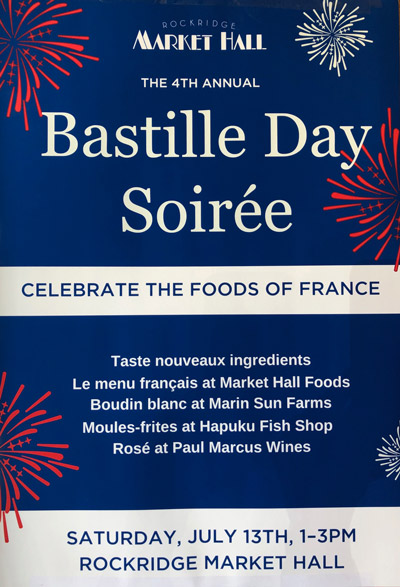
Keeping with tradition and to celebrate the foods and wines of France, Market Hall is hosting a 4th Annual Bastille Day Event! Saturday afternoon July 13th from 1-3pm. Rest assured that there will be a bounty of great products and possible menu items to put together for the big day!
Here at Paul Marcus Wines we’ll be doing our part by showcasing and presenting a range of fabulous rose wines from across France. Dry, crisp, mineral, juicy, we’ve got the perfect pink wine for anyone who is ready to celebrate la Fête nationale.
Please be sure to visit us, and we’ll take you on a rose tour de France. See you at the shop!
International Hummus Day is May 13th!
HolidaysWhile 2019 marks the 7th anniversary of International Hummus Day, this historical dish has culinary roots dating back centuries and is mentioned in 13th century Arabic cookbooks. Not surprisingly, the Arabic word for chickpea is, you guessed it, hummus. Long considered a staple dish in countries like, Israel, Syria, Palestine, Jordan, Egypt and Turkey, hummus takes on various renditions depending upon its origin. However, the principle elements include chickpeas, olive oil, tahini and garlic. The ingredients are ground to a paste, then served as an accompaniment to various fare.
And while hummus is certainly delicious, it is also good for you! Chick peas are nutrient dense members of the legume family, and are a great source of dietary fiber, vitamin B, and plant-based protein. A combination of complex carbohydrates and protein, eating chickpeas can aid in digestion, and help control blood sugar levels throughout the day. It is truly a super dip!
Need some inspiration on how best to celebrate International Hummus Day? For starters, how about whipping up your very own homemade version (so easy and fresh). Then enjoy for breakfast with eggs or toast, lunch as a spread with grilled chicken, then pre dinner outside on the patio with a selection of crudités (as seen above). With all of this hummus celebration, we would be remiss if we did not include an appropriate wine or two to pair with the festivities. A dry southern French rose is our top pick! Also, a sure bet to pair well with hummus, a crisp Spanish Verdejo or Corsican white. We’ve got these and many other vinous options available at Paul Marcus Wines.
How will you enjoy your hummus?
A Guide to Natural Wines at PMW
FAQSHear ye, hear ye! Natural wines at Oakland’s most sophisticated wine shop – Paul Marcus Wines
What’s all this hullabaloo about natural wine? Here at Paul Marcus Wines we get questions – oh so many (wonderful) questions about wine from our customers. Many of these queries, and probably #1 in terms of frequency, involve food and wine. For example, what is the best wine to serve with grilled asparagus and roast chicken (we say Gruner Veltliner!). However, a close second most often involves which wines are produced from vineyards that are organically farmed, and even more specifically, bottles that are “natural wines”.
What is old is often new again, and such is the case with many principles and practices that encompass natural wine. You can learn more about the natural wine movement and its guiding principles in THE ANSWER: A Guide to Natural Wines.
Have we peaked your interest in natural wines? At the shop we’ve posted a natural wine legend (pictured above), to help you easily locate these vinous gems. Our natural wine guide accomplishes two things:
Note: these tags represent only a partial selection of natural wines available at PMW.
Of course, we are always here to answer questions regarding natural wines or provide a recommendation for you. However, we realize that sometimes folks just like to tour the shop, glean information on their own, then grab the perfect natural wine and go. If so, then our natural wine guide and nifty colored tags were made just for you.
We’ll see you at the shop!